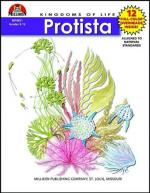|
This section contains 358 words (approx. 2 pages at 300 words per page) |
Protista refers to one of the kingdoms of organisms commonly called protists. They were first described by the German biologist Ernst Haeckel in the 1860s. Until this time, biologists recognized two kingdoms, the Plantae and Animalia. Haeckel observed a group of microscopic organisms with both plant and animal characteristics, such as flagellated cells with chloroplasts. At this time, the Kingdom Protista was proposed. Today, five kingdoms are recognized: Plantae, Animalia, Protista, Fungi, and Monera (bacteria). The protists are sometimes known as the Protoctista (meaning "very first" or "to know"). This kingdom includes approximately 27 phyla and more than 200,000 species.
The Kingdom Protista is a fairly heterogeneous group of unicellular eukaryotes. These organisms share several characteristics in common. First of all, they are unicellular, which means one cell functions as a whole organism where all life functions are carried out. Most protists are motile using pseudopodia ("false feet" extensions of the protoplasm), flagella (whip-like organelles), or cilia (short, hair-like structures). Most parasitic species are non-motile. Asexual reproduction is most common through mitosis, but some species have sexual reproduction as exemplified by conjugation in ciliates. Most species are free living, but many form symbiotic relationships with other organisms including parasitism, commensalism, and mutualism.
Protists live in a wide variety of habitats, including soil, freshwater, marine, and as ecto- and endoparasites. Taxonomically, protists are differentiated by the structure of their cell, types of organelles, and form of reproduction or life cycle. There are three general groups of protists. The first are the plant-like protists, sometimes known as the Protophyta. These include the diatoms or golden algae (Phylum Chrysophyta), dinoflagellates (Phylum Pyrrophyta), euglenoids (Phylum Euglenophyta), and cryptomonads (Phylum Cryptophyta). The animal-like protists are included in the Subkingdom Protozoa. These include the flagellated protozoans like the genus TrypanosomaTrypanosoma, a parasite that causes African Sleeping Sickness and Chaga's disease (Phylum Zoomastigina); amoeboid forms like AmoebaAmoeba, radiolarians, and foraminiferans (Phylum Sarcodina); Ciliates like ParameciumParamecium (Phylum Ciliophora); and parasitic sporozoans like PlasmodiumPlasmodium, a parasite that causes malaria (Phylum Apicomplexa). The fungus-like protista include slime molds, water molds, and mildews. These are sometimes included within this kingdom, but they are usually included in the Kingdom Fungi.
|
This section contains 358 words (approx. 2 pages at 300 words per page) |


